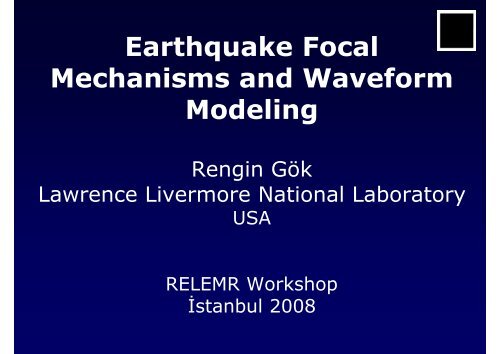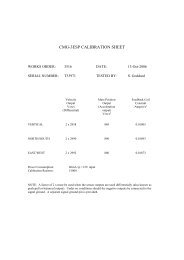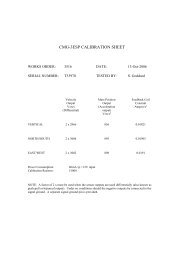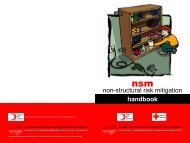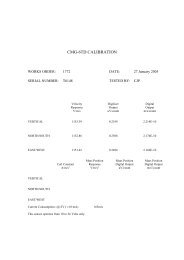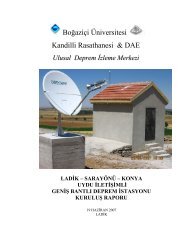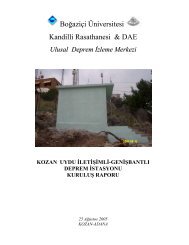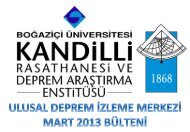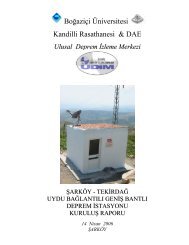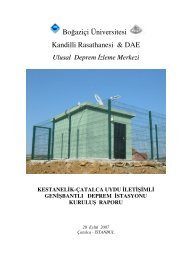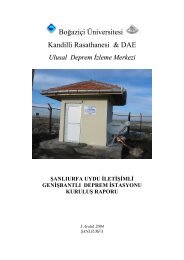Earthquake Focal Mechanisms and Waveform Modeling
Earthquake Focal Mechanisms and Waveform Modeling
Earthquake Focal Mechanisms and Waveform Modeling
Create successful ePaper yourself
Turn your PDF publications into a flip-book with our unique Google optimized e-Paper software.
<strong>Earthquake</strong> <strong>Focal</strong><br />
<strong>Mechanisms</strong> <strong>and</strong> <strong>Waveform</strong><br />
<strong>Modeling</strong><br />
Rengin Gök<br />
Lawrence Livermore National Laboratory<br />
USA<br />
RELEMR Workshop<br />
İstanbul 2008
Gudmundar E. Sigvaldason
The Dynamic Earth, USGS
The size of the event<br />
Scalar seismic moment Mo = μAu<br />
μ is the shear modulus of the rocks involved in the earthquake<br />
A is the area of the rupture along the fault (LxW)<br />
u is the average displacement on A.<br />
L<br />
u<br />
w
Type of faulting <strong>and</strong> slip direction<br />
Strike, Dip, <strong>and</strong> Rake<br />
<br />
<br />
<br />
Strike, the<br />
azimuth of fault<br />
plane<br />
Dip, angle with<br />
the horizontal<br />
Rake, angle<br />
between slip<br />
vector <strong>and</strong> strike<br />
(Shearer, 1999)
Extracting source parameters from<br />
waveforms?<br />
First motion polarity<br />
<strong>Waveform</strong> modeling of<br />
long period body <strong>and</strong> surface waves
First motion polarities
Stein & Wysession, 2003
SOMETIMES FIRST MOTIONS<br />
DON’T CONSTRAIN FOCAL<br />
MECHANISM<br />
Few nearby stations, so arrivals are<br />
near center of focal sphere<br />
Mechanism has significant dip-slip<br />
components, so planes don’t cross<br />
near center of focal sphere<br />
?<br />
?<br />
?<br />
Additional information is obtained by<br />
comparing the observed body <strong>and</strong><br />
surface waves to theoretical<br />
?
Seismic signals<br />
Epicentral<br />
Distance ()<br />
Receiver<br />
Vp1<br />
Vs1<br />
density1<br />
Vp2<br />
Vs2<br />
density2<br />
Depth (h)<br />
Source<br />
Path<br />
Layer1<br />
Layer2<br />
Source + Path + Receiver response
Ground motion<br />
recorded on<br />
seismogram as a<br />
combination of<br />
factors<br />
SYNTHETIC SEISMOGRAM AS CONVOLUTION<br />
Frequency domain
Source signature around the epicenter<br />
Stein & Wysession, 2003
Stein & Wysession, 2003
Relation between fault planes <strong>and</strong><br />
stress axes<br />
P-axis bisects<br />
dilatational<br />
quadrant<br />
T-axis bisects<br />
compressive<br />
quadrant<br />
B-axis intersection<br />
of both nodal<br />
planes<br />
Stein & Wysession 2001
(P)Pressure – Smallest moment<br />
(T)Tension – Largest moment<br />
(N)Null<br />
The eigenvalues are magnitude <strong>and</strong><br />
the eigenvectors are the axes<br />
The axes <strong>and</strong> their eigenvalues are<br />
composed of strike,dip <strong>and</strong> rake
Moment Tensor Basics<br />
A moment tensor is a complete<br />
description of equivalent forces of a<br />
general seismic point source (Jost <strong>and</strong><br />
Herrmann, 1989) in an elastic<br />
medium(Shearer 1999).<br />
M =<br />
M<br />
<br />
<br />
M<br />
<br />
M<br />
11<br />
21<br />
31<br />
M<br />
M<br />
M<br />
12<br />
22<br />
32<br />
M<br />
M<br />
M<br />
13<br />
23<br />
33<br />
<br />
<br />
<br />
<br />
(Shearer, 1999)
Moment Tensors ( 9 components)<br />
Stein & Wysession, 2003
EXPLOSION<br />
EARTHQUAKES<br />
(DOUBLE<br />
COUPLE)<br />
OTHER<br />
SOURCES<br />
(CLVD)<br />
Dahlen <strong>and</strong> Tromp, 1998
<strong>Earthquake</strong>s are mostly<br />
double-couple (DC)<br />
ISO DC CLVD<br />
Bodywave radiation patterns<br />
P amplitude<br />
S amplitude
Surface wave<br />
radiation patterns<br />
(showing DC only)<br />
Julian et al., 1998
TELESEISMIC<br />
BODY WAVES<br />
Initial portion of<br />
seismogram includes<br />
direct P wave <strong>and</strong> surface<br />
reflections pP <strong>and</strong> sP<br />
Hence result depends<br />
crucially on earthquake<br />
depth <strong>and</strong> thus delay<br />
times<br />
Powerful for depth<br />
determination<br />
Stein & Wysession, 2003<br />
Gives information about<br />
rupture processes.
Regional <strong>Waveform</strong> <strong>Modeling</strong> in<br />
Eastern Mediterranean Region<br />
The broadb<strong>and</strong> network coverage is<br />
increasing<br />
The velocity models are getting<br />
improved<br />
Rupture direction <strong>and</strong> depth effects
Very complex regional wave propagation pattern
WENA(Western Eurasia North Africa) Model<br />
The WENA1.0<br />
model is<br />
constructed by<br />
joining a<br />
regionalized<br />
crustal model of<br />
Western Eurasia<br />
<strong>and</strong> North Africa<br />
to a highresolution<br />
sediment model<br />
<strong>and</strong> an<br />
a priori upper<br />
mantle model<br />
(Pasyanos, 2004)
Combining fundamental mechanisms<br />
with earth response (Green’s functions)<br />
Three fundamental mode<br />
synthetics<br />
Sum to produce any<br />
arbitrary mechanism<br />
SS<br />
DS<br />
DD<br />
Dreger, 1999
Synthetic<br />
Seismogram<br />
Vertical<br />
VSS<br />
VDS<br />
VDD<br />
RSS<br />
Radial<br />
RDS<br />
RDD<br />
TSS<br />
Transverse<br />
TDS<br />
TDD
Regional <strong>Waveform</strong> <strong>Modeling</strong><br />
(Body + Surface Waves)<br />
Observed data<br />
• Offset correction (Removal<br />
of mean)<br />
• Rotation for angle of radial<br />
direction<br />
• Instrument response<br />
removal<br />
• Low-pass filtering<br />
Synthetic data<br />
• Green’s functions<br />
for unit source<br />
• Combined with<br />
three fundamental<br />
faults<br />
<strong>Modeling</strong><br />
•Inversion ( e.g. Dreger, 1996)<br />
•Forward modeling (search the best fit for the range<br />
of strike,dip <strong>and</strong> rake) (Walter WR, 1992)
.. small event , good fit<br />
Al-Thoubi et al., GSF 2007
Resources<br />
<br />
NEIC fast moment tensors - from teleseismic P waveforms<br />
http://gldss7.cr.usgs.gov/neis/FM/fast_moment.html<br />
<br />
Harvard CMT solutions - Centroid moment-tensor<br />
(from teleseismic long period body waves)<br />
http://www.seismology.harvard.edu/projects/CMT/<br />
<br />
EMSC rapid source parameter determination - European-<br />
Mediterranean Seismological Centre - uses P & S waves –<br />
results in 24 hours<br />
http://www.emsc-csem.org/<br />
<br />
NEIC broadb<strong>and</strong> depths <strong>and</strong> fault-plane solutions<br />
http://neic.usgs.gov/neis/nrg/bb_processing.html<br />
<br />
Swiss (ETHZ) moment tensor solutions –Regional moment<br />
tensor inversion


